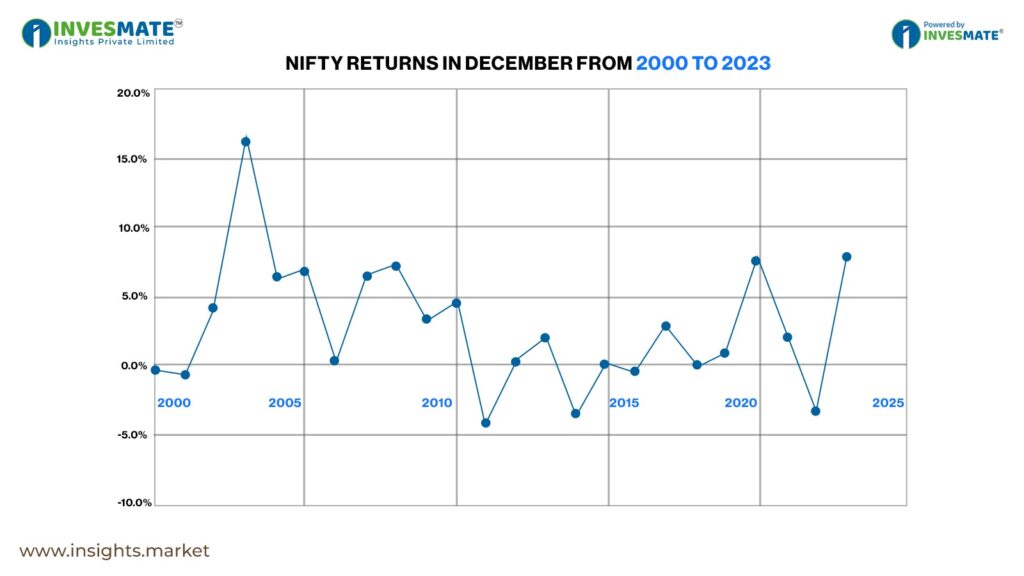![]()
As the year winds down, the December Effect emerges in the Indian stock market, characterized by a notable uptick in stock prices. This trend is driven by factors such as portfolio rebalancing from institutional investors and increased consumer spending during the festive season. Let’s dive into what drives the December Effect, what happened this year, and what investors can expect going forward.
What is the December Effect?
The December Effect is a phenomenon where the Indian stock market tends to perform better during the last month of the year. Historically, December has shown positive returns in many years, but it also has its share of downturns.
Here’s why:
- Year-End Portfolio Adjustments: Big investors, like mutual funds and foreign investors, often adjust their portfolios in December to meet annual targets. This usually means buying more stocks, which can push prices up.
- Festive Spending: With festivals like Diwali and Christmas, consumer spending increases. More spending boosts company earnings, which can make investors more confident in the stock market.
- Foreign Investments: Foreign Institutional Investors (FIIs) often pour money into Indian stocks in December, especially in sectors like IT and consumer goods, adding extra fuel to the market.
- Economic Recovery: When the economy is growing, December can see stronger market performance. In recent years, recovery efforts have helped boost investor confidence.
How Has December Performed Over the Years?
Looking back at past Decembers gives us an idea of how the market tends to behave:
Since 2000, the Nifty Index has gone up in 17 out of 24 Decembers, a success rate of about 71%.
- Best years: In 2003, the market soared by 16.4%, and in 2023, it grew by 7.9%.
- Tough years: Some years have seen losses, like 2011 (-4.3%), 2014 (-3.6%), and 2022 (-3.5%).
While December often brings positive returns, it’s not guaranteed. The market can sometimes take unexpected dips.
The Volatile Side of December
December is also one of the more volatile months in the stock market. Here’s Why?
- Investor Optimism: The excitement about the upcoming year can drive more market activity, leading to fluctuations.
- Speculations: News or rumors about government policies or company plans can stir up the market.
- Festive Spending: While higher consumer spending is good, it can also create some instability if it doesn’t match expectations.
Volatility means there are chances to make money, but also risks. Investors need to stay alert and make careful decisions.
What Happened in December 2024?
December 2024 has been a mixed bag for the Indian stock market. The Nifty 50 index saw a slight decline of 0.69% by December 30, with key sectors like IT and Auto weighing it down.
- IT Sector: The IT sector faced pressure as investors lowered expectations for U.S. interest rate cuts, which hurt companies with heavy exposure to the U.S. market. However, stocks like Tech Mahindra did well, gaining 2.04% on December 30.
- Banking Sector: Banks like HDFC saw declines, with shares falling 1.07% as investors took profits.
Some good news came from foreign investments, as foreign funds continued to support the market. Additionally, policy changes like the Reserve Bank of India’s move to inject liquidity helped keep investor sentiment positive.
What to Expect Going Forward
As we move toward the new year, here’s what investors should keep in mind:
- Good News for Liquidity: The Reserve Bank of India’s recent decisions to cut the Cash Reserve Ratio (CRR) will put more money into the economy, helping market liquidity. This could provide a boost, especially in the short term.
- Sector Strengths: Sectors like IT, banking, and consumer goods are expected to remain strong. Even if the market dips, these sectors are likely to perform better than others.
- Global Factors: The U.S. Federal Reserve’s rate cuts could encourage more foreign investment in emerging markets like India. This might help lift the market in the coming months.
However, there are some challenges too:
- Slower GDP Growth: India’s economy is expected to grow at a slower pace than originally predicted, which could affect market performance.
- Inflation Worries: Rising food prices and supply chain issues may limit market growth.
- Increasing Tariffs: New trade tariffs could negatively affect sectors like IT and manufacturing.
Final Thoughts: December – A Time for Caution and Opportunity
The December Effect is real, but it’s not a sure thing. While the market has a tendency to rise in December, there’s always the potential for surprises. As 2024 comes to a close, investors should be aware of the volatility and stay focused on sectors that are likely to perform well, such as IT, banking, and consumer goods.
If you’re planning to invest, remember to balance risk with opportunity. December might bring some ups and downs, but with careful planning, it can still be a rewarding month for savvy investors. For more insights, check out our guide on income taxes for investors.
Happy investing, and here’s to a prosperous 2025.







One Response
Nocomment